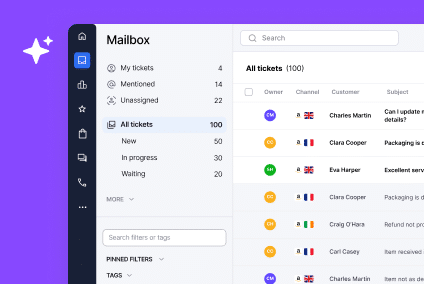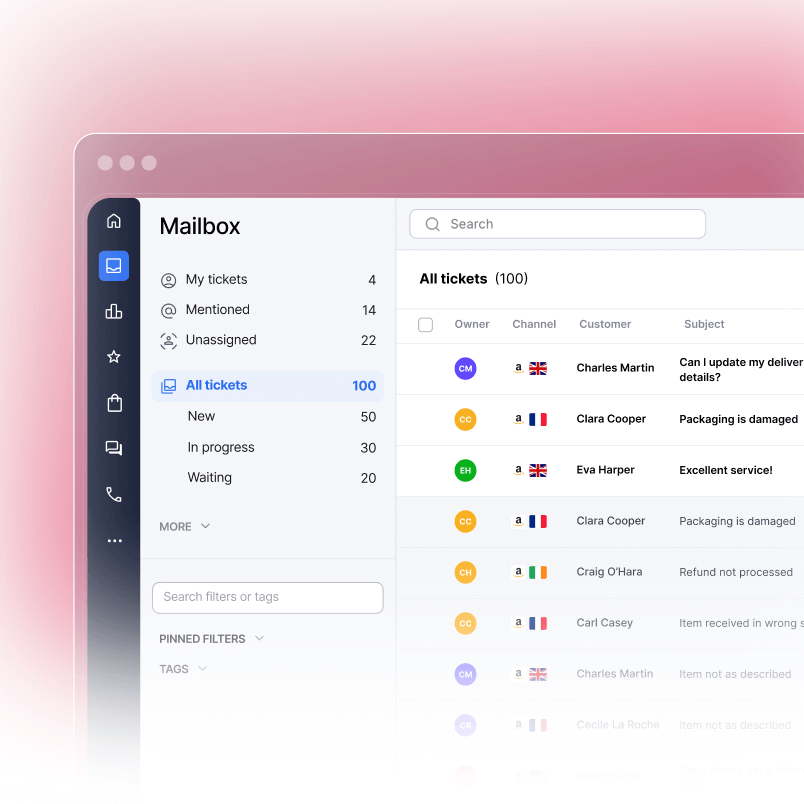Running a Shopify store means handling customer questions every single day. Some arrive during your lunch break. Others come in at midnight. Your customers expect answers fast, and they expect them across multiple channels. If you’re managing support solo or with a small team, this feels impossible. The truth is, it’s not about working harder. It’s about working smarter with the right tools and processes.
This guide covers what actually works. You’ll learn which apps deliver real results, how to set response time goals your team owns, and automation flows that deflate your support volume without frustrating customers. Whether you’re a solo founder handling everything or scaling a support team, you’ll find strategies that fit your operation.
Why Shopify Stores Need Dedicated Customer Support
Direct-to-consumer expectations have shifted. Your customers buy from you because they trust you, and that trust breaks fast when support feels slow or impersonal. Research shows that 75% of customers will never return after a single negative customer service experience. A delayed response doesn’t just frustrate one customer. That customer leaves a review. They tell friends. Your brand reputation takes the hit. Companies prioritizing customer experience report 80% higher revenue growth compared to those that don’t.
Ticket volume spikes during promotions and product launches. A single flash sale can generate hundreds of questions in hours. Without systems in place, your team drowns. Email piles up. Chat requests timeout. The quality of your responses tanks.
Post-purchase support directly impacts retention. A customer who gets help with a sizing issue comes back. A customer who never hears back doesn’t. Studies show that fast, helpful support reduces refund requests and increases repeat purchases by up to 30%. Support isn’t a cost center. It’s a revenue driver. 72% of customers expect companies to understand their individual needs, which requires responsive support.
Your customers contact you through multiple channels now. They’ll email you about an order. They’ll DM you on Instagram. They’ll text your WhatsApp. Meeting them where they already are keeps support efficient and customers happy. In fact, 64% of customers expect businesses to respond on social media. Research shows that 75% of customers prefer omnichannel support, meaning they want consistent experiences across all touchpoints.
Key Support Channels Shopify Brands Should Offer
Live chat gives you instant connection with browsers on your store. Response time matters here. Customers using chat expect answers within minutes, not hours. This channel handles product questions before purchase and post-order issues after. Businesses that offer live chat see 13% higher customer satisfaction rates compared to those without it.
Email remains the backbone of support. It’s where detailed issues land. Returns questions. Damaged product claims. Technical problems. You need email, but you also need a system to track and prioritize incoming messages. Email continues to be the preferred contact method for 72% of customers when reaching out to brands.
Social DMs through Instagram and Facebook are where younger customers reach you. You can’t ignore these. A Facebook message feels personal to your customer, and they expect a response like they would from a friend. Integration matters here. Monitoring three separate inboxes burns time. Mobile commerce on social platforms has grown 40% year-over-year, making social support increasingly critical.
SMS reaches customers directly on their phone. Use it for order updates, delivery notifications, and support escalations. Response rates are higher than email because the message shows up immediately. SMS open rates exceed 98%, making it one of the fastest ways to reach customers.
Embedded help widgets and self-service tools reduce your incoming volume. A customer who finds their answer in a searchable FAQ doesn’t open a support ticket. This is your first line of defense. Self-service reduces support costs by up to 50%.
Best Practices for Response Times
Chat requests should get a response within one minute. If you can’t staff live chat constantly, say so upfront. A message that says “We’ll be back in 2 hours” is better than a customer staring at a blank screen wondering if anyone’s there. Customers who receive chat responses within the first minute are 7x more likely to make a purchase.
Email replies should go out within four hours during business hours. This sets customer expectations without burning out your team. Some stores aim for faster. Some operate globally and spread coverage across time zones. Pick a number your team owns and stick to it. Companies that respond to customers within 1-2 hours are 10x more likely to build lasting customer relationships.
Autoresponders are your friend here. A customer gets an immediate message saying “We got your email and we’ll respond by 5 PM EST.” This one message reduces follow-up emails by half. People aren’t frustrated by waiting. They’re frustrated by not knowing when you’ll respond.
Escalation workflows separate routine questions from complex ones. A customer asking for a refund goes to a manager. A customer asking about your return window goes to an automated response with your policy. Your team focuses on issues that matter.
VIP customers get priority. If someone spent $500 in the last year, their issue moves to the front of the queue. This doesn’t take extra work. Your support app does this automatically.
Recommended Shopify Customer Service Apps
eDesk is built specifically for Shopify merchants who want to scale support without the complexity. It unifies all your customer conversations in one inbox. Email, live chat, social DMs from Instagram and Facebook, and SMS all appear in the same interface. You see the entire order history for each customer without switching tabs. Macros let you respond to common questions with one click. The app learns what your team asks most and suggests responses automatically. eDesk users report a 40% reduction in average response time and handle 3x more conversations in the same amount of time. Pricing is transparent and scales with your business, making it accessible for solo founders and growing teams alike.
App Comparison
| App Name | Best For | Key Features | Starting Price |
| eDesk | Shopify-first brands | Multichannel inbox, order history, macros, AI suggestions | Transparent pricing |
| Re:amaze | Multichannel teams | Unified inbox, FAQ widget, chatbot | $50/month |
| Zendesk | Enterprise scaling | Advanced routing, custom workflows, reporting | $55/month |
| Tidio | Budget-conscious stores | Live chat, AI chatbot, easy setup | $9/month |
| DelightChat | WhatsApp-first brands | WhatsApp support, DTC focus, Instagram DMs | $25/month |
Automation Strategies That Scale Support
Auto-tagging means your support app sorts incoming messages automatically. A customer mentioning “refund” gets tagged as a refund request. A customer asking “When will my order arrive” gets tagged as shipping. Your team knows exactly what they’re dealing with before opening the ticket. Automation can reduce manual tagging work by 80%.
Smart routing sends issues to the right person or team. Refund requests go to your manager. Product questions go to your product specialist. Shipping questions go to your fulfillment team. People work on what they know, and response quality improves. Smart routing increases first-contact resolution rates by up to 45%.
Order status macros automate routine information. Your customer asks where their package is. You click a macro. The system pulls their order, finds the tracking number, and sends it in a personalized message. This takes three seconds instead of three minutes. Teams using macros save an average of 2-3 hours per day.
Abandoned cart follow-ups reach customers who left items in their cart. An automated message one hour later says “You left something behind.” Many customers complete the purchase without opening a support ticket. Abandoned cart recovery emails have a 21% open rate and generate 4-6% in additional revenue.
Feedback request triggers send post-purchase surveys automatically. After 10 days, a customer gets an email asking about their experience. This generates reviews and surfaces problems before customers post complaints publicly. Brands that request feedback see a 30% increase in positive online reviews.
Chatbots handle FAQs and returns. A customer asks “What’s your return window?” The bot responds instantly. A customer asks something the bot doesn’t recognize, and it routes to your team. This removes 30 to 50 percent of your incoming volume on day one. AI-powered chatbots handle 85% of customer service interactions successfully.
Self-Service and Help Center Optimization
Your help center is your second line of defense. When customers find answers themselves, they’re actually happier than waiting for your reply. You avoid a support ticket, and customers get instant answers. In fact, 69% of customers prefer self-service options over speaking to support agents.
Write searchable help articles covering your most common questions. Shipping times. Return policies. Sizing guides. Damaged product procedures. Track what customers ask about most, then write about those topics first. Help articles ranked in search results can drive 20-30% of your support site traffic.
Link help articles in your order confirmation emails. A customer reads “Your order shipped” and immediately sees a link to your shipping help article. If they have questions, they know where to find answers without opening email.
Use Shopify’s native FAQ builder or embed third-party widgets on your product pages. When a customer visits your product page wondering “Is this true to size?”, they find the answer before buying. This reduces post-purchase sizing questions by a lot. Adding product-level FAQs can reduce returns by up to 15%.
Measuring Support Performance on Shopify
CSAT (Customer Satisfaction Score) tells you whether customers are happy with your support. Ask one question after each resolved ticket: “Were we helpful?” This number should be above 80 percent. Below 70 percent signals something’s broken. The average CSAT score for ecommerce support is 75%.
First response time (FRT) measures how fast you answer. Track this by channel because chat and email have different expectations. Chat under 1 minute. Email under 4 hours. This is your operational metric. The average FRT for top-performing ecommerce brands is 2 hours for email.
Resolution time tracks how long it takes to fully solve a problem. This is different from response time. You might respond in 30 minutes, but the customer’s package doesn’t arrive for another week. Track how long customers wait for their actual problem to resolve. Most customers expect issues to be resolved within 24-48 hours.
Deflection rate measures how many customers help themselves. If your deflection rate is 10 percent, only 10 percent of potential support requests become tickets. This is pure efficiency. Aim to increase this number constantly. Top ecommerce brands achieve deflection rates of 35-40% through self-service.
Set different goals per channel. Chat has faster expectations. Email can be slower. Social DMs fall somewhere in the middle. Your app dashboard should show you each metric broken down by channel.
Final Summary
Great Shopify support doesn’t require a massive team. It requires the right systems. Pick two or three support apps that fit your operation. Set response time goals your team owns. Automate routine answers. Build a help center that actually helps.
Start with one automation workflow this month. Choose the one that will save your team the most time. Track the impact. Next month, add another. You’ll feel the difference fast.
FAQs
What is the best customer service app for Shopify?
eDesk is the best customer service app for Shopify. It’s purpose-built for Shopify merchants, so integration is seamless and works out of the box. You get multichannel support across email, live chat, Instagram DMs, Facebook messages, and SMS all in one unified inbox. The app automatically pulls your entire order history so you have complete context for every customer conversation. Macros save your team hours by automating repetitive responses. AI suggestions learn from your support patterns and improve daily. Whether you’re a solo founder or managing a growing team, eDesk scales with you. Start your free trial today.
How fast should I reply to customer emails?
Aim for four hours during business hours. Set this expectation in your autoresponder so customers know when to expect your answer. If you can reply faster, great. If four hours is your limit, own it and communicate it. Research shows brands that maintain consistent FRT build stronger customer loyalty.
Can I automate Shopify support?
Yes. Automate routine answers, order lookups, and tagging. Don’t automate complex problems that need human judgment. The balance between automation and human touch keeps customers happy and your team sane. Most successful brands use automation to handle 30-50% of requests.
How do I offer support via Instagram and WhatsApp?
eDesk handles both Instagram DMs and WhatsApp natively within the platform. You monitor one unified inbox instead of jumping between multiple apps. This saves hours every week and keeps your brand voice consistent across all channels. Setup is simple, and you’ll be supporting customers on social within minutes. With eDesk’s multi-channel support, your team can handle 3x more conversations in the same amount of time.
You monitor one inbox instead of jumping between apps. This saves hours every week. Multi-channel support apps let your team handle 3x more conversations in the same time.
What metrics matter most for Shopify support?
Track CSAT, first response time, and resolution time. These three numbers tell you if your support is working. CSAT tells you if customers are happy. Response time tells you if you’re fast. Resolution time tells you if you’re actually solving problems. Brands that track all three metrics improve customer retention by 22% on average.
How many support staff does my store need?
This depends on your ticket volume. Most Shopify stores start solo. One person handles everything until you hit 2,000 to 3,000 tickets per month. Then hire someone part-time. Track your team’s capacity to know when it’s time. Each support agent can typically handle 30-50 tickets per day depending on complexity.




